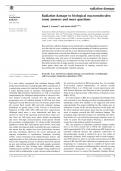Examen
Radiation damage to biological macromolecules: some answers and more questions
- Cours
- Établissement
Radiation damage to biological macromolecules: some answers and more questions Elspeth F. Garmana * and Martin Weikb,c,d,e* a Laboratory of Molecular Biophysics, Department of Biochemistry, University of Oxford, South Parks Road, Oxford OX1 3QU, UK, bComissariat a` l’Energie Atomique, Insti...
[Montrer plus]



